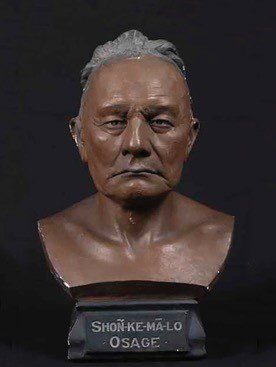National Portrait Gallery Acquires Portrait of Shonke Mon thi^ by Artist Ken Gonzales-Day

“Shonke Mon thi^, (Shunkamolah), Osage.” Bust made April – Dec. 1904 by Frank Lemon. Photograph by Ken Gonzales-Day. National Portrait Gallery, Smithsonian Institution
The Smithsonian’s National Portrait Gallery announces the acquisition of a photograph of the bust of Shonke Mon thi^, who was a prominent warrior and spiritual leader of the Osage people and hereditary Chief of the Pa tso li^ Big Hill Band at the turn of the 20th century. This work by Latino artist Ken Gonzales-Day was first displayed by the Portrait Gallery in “UnSeen: Our Past in a New Light, Ken Gonzales-Day and Titus Kaphar,” which was presented as part of the museum’s 50th anniversary exhibition program.
“The acquisition of this portrait not only provides us with an opportunity to present a more inclusive view of American history but also to reflect on how museums have acknowledged the identities and contributions of Native Americans,” said Taína Caragol, Curator of Latino Art and History, Smithsonian’s National Portrait Gallery. “We are delighted to welcome this work into the Portrait Gallery’s collection, in accordance with the wishes of Dr. Steven Pratt and Dr. Joseph Shunkamolah, great-grandchildren of Shonke Mon thi^, as well as the Osage Nation Historic Preservation Office and the Traditional Cultural Advisors Committee.”
In the early 20th century, Shonke Mon thi^ was a priest and one of the most decorated warriors of the Osage. In his role as priest, Shonke Mon thi^ closely guarded specific clan rituals. He was also an early practitioner of the Native American Church. By the end of his life in 1919, he had received all thirteen war honors or O-don from his Nation. As a young man, he earned his name, which translates to “Walking Dog,” for his remarkable ability to run long distances, carrying messages between Osage chiefs. In 1863, Shonke Mon thi^ was commended as a warrior for his role in an attack on Confederate troops in Kansas. He joined a delegation of Osage leaders who traveled to Washington, D.C., to negotiate land and mineral rights in 1904. According to oral tradition, Anglo-Americans unable to pronounce his name called him Shunkamolah. Around this time, Shonke Mon thi^ also assisted Smithsonian anthropologist Francis La Flesche (himself an Omaha Tribe member) in documenting Osage cultural practices.
The image of Shonke Mon thi^ is part of Gonzales-Day’s series Profiled (2008–present), in which the artist photographs figurative sculptures in American and European museum collections in order to explore conceptions of racial difference and beauty in art. By displaying the sculptures against stark backgrounds, the artist reveals the differences in how white bodies and bodies of color are portrayed, contextualized and interpreted. In 2014, under the auspices of a Smithsonian Artist Residency Fellowship, Gonzales-Day documented the representation of Native American historical figures in the Smithsonian Institution’s collections. He found very few indigenous sitters in the Portrait Gallery’s sculptural holdings. By contrast, a multitude of sculptures at the National Museum of Natural History represent Native Americans. The vast majority of these works, including the bust of Shonke Mon thi^, were based on molds made from the faces of living individuals. Photographs of Native Americans at their reservations or in Washington, D.C., on diplomatic missions served as additional references. The aim of the finished sculptures, which were exhibited primarily at world’s fairs, was not to commemorate the sitters’ achievements. Rather, they served as tools for anthropological study. For Gonzales-Day, the act of photographing these individuals’ busts and researching their lives is a way to recognize their importance and ultimately include them in the collection of art museums.
In order to restore their ancestor’s original name, the sitter’s descendants led the initiative to change the title of the sculpture from Shunkamolah to Shonke Mon thi^ in museum records. His descendants continue to work as stewards of Osage culture and language, and of the Native American Church.
The Smithsonian’s National Portrait Gallery tells the multifaceted story of the United States through the individuals who have shaped American culture. Spanning the visual arts, performing arts and new media, the Portrait Gallery portrays poets and presidents, visionaries and villains, actors and activists whose lives tell the American story.
The National Portrait Gallery is part of the Donald W. Reynolds Center for American Art and Portraiture at Eighth and F streets N.W., Washington, D.C. Smithsonian Information: (202) 633-1000. Connect with the museum at npg.si.edu, Facebook, Instagram, Twitter, and YouTube.
# # #
SI-349-2019
